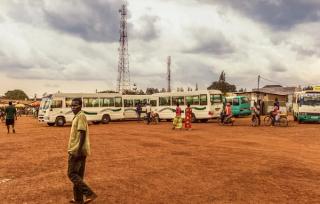
Vision-led planning - Pickerings Farm
- Client Name
- Vision-led planning - Pickerings Farm, Penwortham
- Location
- Preston, UK

SLR was appointed by Homes England and Taylor Wimpey to provide an alternative approach to a planning application for a site of 1,100 homes. A previous application had been submitted based on predict and provide method, resulting in the highway authority calling for substantial mitigations, including a new bridge over the west coast mainline and other off-site junction improvements. This included contributions to a county led dualling scheme. This would have resulted in significant increase in car mileage and carbon emissions, therefore it was deemed unviable and was rejected.
Challenge
The challenge SLR faced was to demonstrate that accessibility by the highest forms (i.e. active travel and shared travel) could still be achieved through connections to the existing communities which this site would form a part of, rather than solely providing highway network capacity improvements to protect the convenience of the car commuter.
Solution
SLR was appointed as market leaders in delivering the vision and validate approach to transport planning. In sharing a common philosophy with our client partners, we presented a vision where people can live locally, with strong community amenities, whilst connected to regional centres through active travel corridors and sustainable shared mobility services. This liveable vision was prepared in the context of furthering the health and climate agenda.
A legal agreement was drafted to provide the necessary commitments for local facilities, including the community concierge, mobility hub, local shop, active travel routes and shared mobility systems, all of which are to be delivered as ‘infrastructure’ on first occupation. Provision of these facilities is made possible by prioritising budget in these areas rather than on traditional road building plans.
SLR established the resulting trip containment and mode shift potential of these placemaking and mobility measures. Traffic impact was assessed, and the likely effects was estimated, with a high bar set in terms of the importance of those effects compared with the importance of design and liveability.
The case was ultimately heard at a Public Inquiry in front of an inspector in the summer of 2022, with SLR providing the service of expert witness. It became a clearly defined battle between a vision and validate approach for development, and a predict and provide approach against development.
SLR successfully gained buy-in from the inspector by carefully illustrating the multi-faceted benefits from the vision-led approach, and how it supported National Planning Policy Framework (NPPF) and other policy priorities.
Impact
The inspector recommended to the Secretary of State (SoS) that the scheme was to be approved. The SoS agreed and granted consent which was published in late 2023.
This is a landmark case study and acts as a precedent for future schemes to continue to push for vision-led, low carbon, and healthy communities.
This project reinforces our belief in vision and validate - that designing for the community, to minimise carbon, and to maximise health should carry far greater weight, than designing to accommodate an unfettered forecast in traffic. The vision leads, and should not be significantly compromised by traffic constraints.
Prioritising investment in the highest forms of accessibility can avoid the need to increase highways capacity - namely the provision of the community concierge, mobility hubs, work hub, shared mobility services and active travel alongside other community amenities can reduce the need to travel for many purposes.
The decision also confirmed that prior congestion is not a good reason for the refusal of planning permission for an otherwise sustainable residential development. A major success factor was implementing a network micro-simulation model to explore dynamic routing and real-world metrics, such as journey times, rather than relying on isolated junction models which are unreliable when assessing congested networks and time periods.
"SLR offered a forward-thinking consultancy team, providing expertise from the vision-led perspective. They demonstrated how the scheme was policy compliant and emphasised equal weight of community, health, and carbon outcomes alongside congestion mitigation measures."
Homes England

